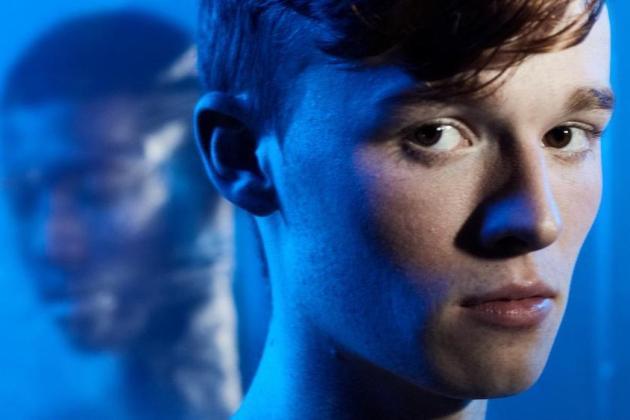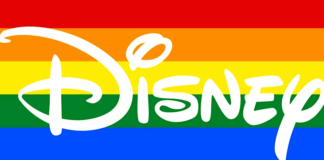
We never learn the name of the main character in Samuel Van Grinsven’s fearless queer debut, “Sequin in a Blue Room.” Anonymous is just the way he likes it. Using a gay cruising app, he goes by the handle “Sequin,” seeking casual, no-strings sex from strangers. Once the hookup’s complete, he blocks the other party, so they can’t contact him again. And then he goes searching for his next thrill.
A redheaded twink (more cocky than callow, as embodied by newcomer Conor Leach) who meets his trysts in a sparkling silver club top, Sequin is just 16, but he knows what he wants — or at least he thinks he does. Such confidence can be disarming, since most kids haven’t figured themselves out yet at that age, which makes them easy prey for more experienced partners. But Sequin seems to intuit the power that youth and beauty confer upon someone in his position, and this single-minded young man has no intention of squandering it.
Van Grinsven opts not to dwell on the cautionary side of his striking 21st-century coming-out/coming-of-age fable. The risks are self-evident, but there’s no room for judgment in a film that nimbly blends elements of fantasy and thriller, delivered with the heightened attitude of New Queer Cinema auteur Gregg Araki (the opening credits, which read “A Homosexual Film by Samuel Van Grinsven” in the same sharp, slanted font of “The Doom Generation,” are a dead giveaway as to his influences). DP Jay Grant’s ethereal aesthetic eroticizes practically everything, whether or not audiences are comfortable watching an underage character get off at dream-like, indigo-hued sex parties or in the overlit yellow stall of a school bathroom.
Danger be damned. Van Grinsven is conscious of consequences, but more interested in exploring the newfound freedoms that technology offers queer self-discovery. The New Zealand-born, Australia-based director belongs to a generation that has little use for the proverbial closet: An awareness of sex — both gay and straight — is now thrust upon millennials from a young age, as kids find themselves but a few keystrokes away from hardcore porn, while mainstream media goes out of its way to normalize the LGBT behavior it once treated as taboo. Gone are the days when one surreptitiously had to seek out “Brokeback Mountain” or “Maurice” at the video store for some glimpse of one’s own desires on-screen.
But access doesn’t stop at explicit imagery. Since the early ’90s, digital tools have made it possible for queer teens to connect with like-minded people, both online and IRL. For Sequin, arranging sex is as easy as ordering a meal on Postmates, and he does it far more frequently. Ten times, to be precise. The movie is organized according to the 10 apartments Sequin visits over a span of just a few days — not so much chapters as the events that mark his existence.
Sequin seems totally distracted in his daily life, checking in on the app at all times: on the subway, in school, at home with his single dad (Jeremy Lindsay Taylor). He’s out to his father, and it’s a welcome if somewhat surprising detail that dad accepts his son’s sexuality. In so many gay teen films, parental disapproval serves as the principal conflict. Of course, if the man knew how far Sequin was going with strangers, he probably wouldn’t be so easygoing. But this movie is all about testing the limits — which is where the other half of the title comes in.
After a couple of early quickies with men a dozen years older or more — sometimes much more, as in the case of “B” (Ed Wightman), a married man who fixates on Sequin — the lad receives an offer via the app to attend a “Blue Room” group sex session. He’s on his phone in class when the invitation comes through, getting pathetic puppy-dog looks from awkward fellow student Tommy (Simon Croker). Tommy’s a bit old school, relying on in-person courtship techniques to get Sequin’s attention — though these two are nowhere near one another’s wavelengths. The movie’s biggest weakness is the conventional way it falls back on Tommy, after Sequin has reached rock bottom.
But Van Grinsven plays it safe, pulling back from the brink and putting a conservative coda on the film. (I’m reminded of “Rocket Man,” which implied that Elton John’s troubles were over when he went to rehab. But addictions — whether sexual or substance-based — are not so easily “cured.”) The film follows — or rather leads — Sequin on a trajectory from casual sex to in-over-his-head kinks, suggesting that an unfamiliar beauty (Samuel Barrie) from the Blue Room party makes enough of an impression to rupture his one-and-done routine.
Sequin’s actual psychology is left vague enough for audiences to puzzle out, since Van Grinsven’s script, co-written with Jory Anast, minimizes dialogue (more than half the movie’s communication is delivered via floating social media exchanges on-screen) and therefore has a tendency to obscure the characters’ motivations. Such ambiguity can work to the film’s advantage, provided that audiences have enough life experience to recognize how Sequin’s behavior connects to their own youthful impulses. Not everyone was daring enough to find a Blue Room, or so obsessive as to stalk (or be stalked) by past tricks, but the principles are universal enough to render this dark journey illuminating, like a sequin top in a dimly lit sex club.
Best of Variety
Sign up for Variety’s Newsletter. For the latest news, follow us on Facebook, Twitter, and Instagram.








